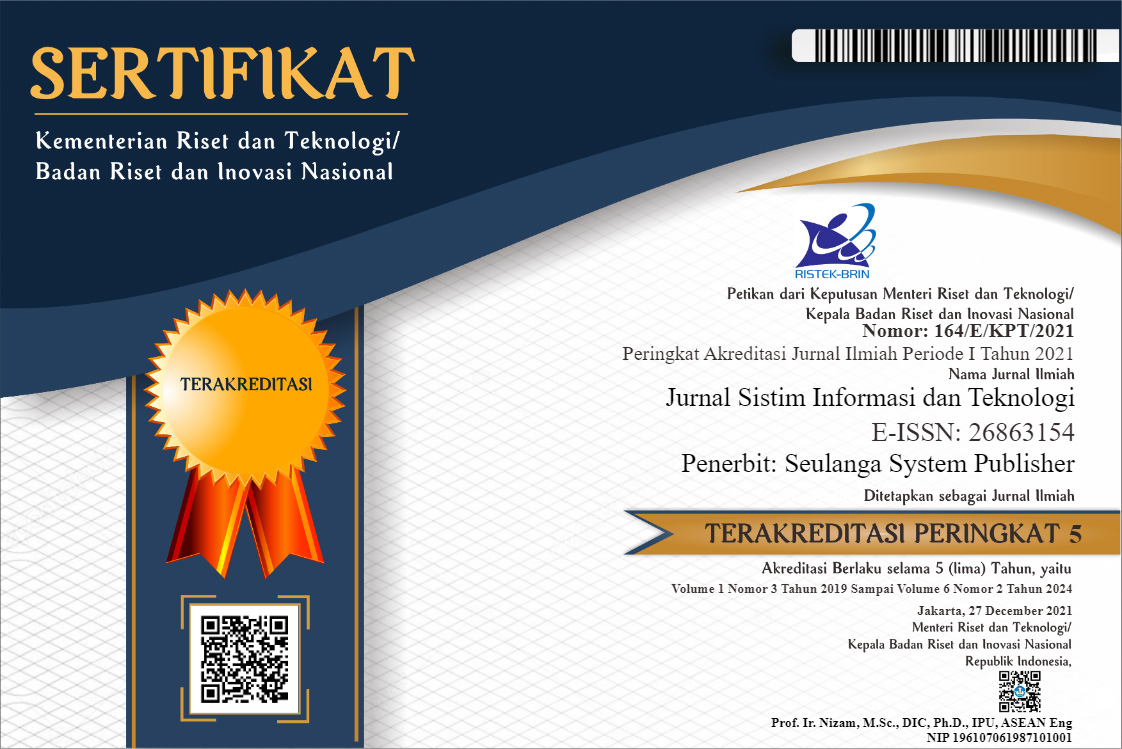Identifikasi Citra Paru-Paru pada Pasien COVID-19 dengan Teknik Edge Detection
DOI:
https://doi.org/10.37034/jsisfotek.v4i4.146Keywords:
Edge Detection, Lungs, COVID-19, Peak Signal to Noise Ratio, Mean Square ErrorAbstract
X-ray chest radiographs produce digital radiographic images of the chest area such as the lungs, heart and ribs. This image can visualize the lung condition of patients with COVID-19. The Edge Detection technique can see the edges of objects in the lungs of COVID-19 patients more clearly. The lungs of patients with COVID-19 are damaged due to the GGO (Ground Glass Opacity) COVID-19, namely there is white fog, the lungs look blurry at the edges or areas affected by the disease and also affect the area of the area. This technique can make it easier for health workers to see X-ray results on objects in the lungs of COVID-19 patients and assist doctors in handling COVID-19 patients. With advances in the computer field in the application of image processing techniques, this Edge Detection Technique uses Matlab software to obtain edge and area images of clean lungs in COVDI-19 patients. The data used in this study were 30 samples of lung images of COVID patients and 10 images of healthy patients' lungs as a comparison sourced from Embung Fatimah Hospital Batam, which were processed in the grayscale stage, then the image was preprocessed with Intensity Adjustment then segmented with Active Contour and then using Edge Detection Technique. The results of this study were as many as 22 lung images produced an accuracy value of 73%. The image of the test results with the Edge Detection Technique to identify the edges of the object's lungs of COVID-19 patients which are quite clear by producing white pixels that are so visible. The perimeter of the right lung of COVID-19 patients ranged from 110,897 - 261,254 mm and Area 267,719 - 940,668 mm2, Perimeter of the left lung ranged from 114,613 - 262,943 and Area 170.616 - 856,993 mm2, while healthy patients as comparison had the right lung Perimeter range of 187,598 -270,624 and Area 514,947 - 1025.44 mm2, Perimeter of the left lung 182,226 - 287,358 and Area 480,592 - 901,418 mm2 means that COVID-19 virus infection reduces lung area, the range of COVID-19 lungs is lower than healthy lungs.
References
Lisnawati, E., & Purwanto, A. (2022). APLIKASI WHATSAPP SEBAGAI MEDIA PEMBELAJARAN DARING DI MTs MUHAMMADIYAH SRUMBUNG, KABUPATEN MAGELANG. Galois: Jurnal Penelitian Pendidikan Matematika, 1(2), 1-9. https://doi.org/10.18860/gjppm.v1i2.2146
Kim, M. S., Kim, M. S., Lee, G. J., Sunwoo, S. H., Chang, S., Song, Y. M., & Kim, D. H. (2022). Bio‐Inspired Artificial Vision and Neuromorphic Image Processing Devices. Advanced Materials Technologies, 7(2), 2100144. https://doi.org/10.1002/admt.202100144
El Naqa, I. M., Li, H., Fuhrman, J. D., Hu, Q., Gorre, N., Chen, W., & Giger, M. L. (2021). Lessons learned in transitioning to AI in the medical imaging of COVID-19. Journal of Medical Imaging, 8(S1), 010902. https://doi.org/10.1117/1.JMI.8.S1.010902 Na`am, J. (2017). Edge Detection on Objects of Medical Image with Enhancement multiple Morphological Gradient (EmMG) Method. 4th Proc. EECSI. 23-24 Sep. 2017. Yogyakarta: Indonesia. http://dx.doi.org/10.1109/EECSI.2017.8239085
Shomirov, A., & Zhang, J. (2021, March). An Overview of Deep Learning in MRI and CT Medical Image Processing. In 2021 3rd International Symposium on Signal Processing Systems (SSPS) (pp. 72-78). https://doi.org/10.1145/3481113.3481125
Guan, W.-jie, Ni, Z.-yi, Hu, Y., Liang, W.-hua, Ou, C.-quan, He, J.-xing, Liu, L., Shan, H., Lei, C.-liang, Hui, D. S. C., Du, B., Li, L.-juan, Zeng, G., Yuen, K.-Y., Chen, R.-chong, Tang, C.-li, Wang, T., Chen, P.-yan, Xiang, J., … Zhong, N.-shan. (2020). Clinical characteristics of Coronavirus DISEASE 2019 in China. New England Journal of Medicine, 382(18), 1708–1720. https://doi.org/10.1056/nejmoa2002032
Bambang Pilu Hartato. (2021). Penerapan convolutional neural network Pada Citra Rontgen Paru-paru untuk Deteksi SARS-COV-2. Jurnal RESTI (Rekayasa Sistem Dan Teknologi Informasi), 5(4), 747–759. https://doi.org/10.29207/resti.v5i4.3153
Supriyanti, R., Alqaaf, M., Ramadhani, Y., & Widodo, H. B. (2021). Morphological characteristics of X-ray thorax images of COVID-19 patients using the Bradley Thresholding segmentation. Indonesian Journal of Electrical Engineering and Computer Science, 24(2),1074. http://doi.org/10.11591/ijeecs.v24.i2.pp1074-1083
Saputra, R. A., Reskal, R., & Wahyuni, F. M. (2022). Segmentasi Pada Plat Kendaraan Dinas dengan Metode Deteksi Tepi Canny, Prewitt, Sobel, & Roberts. J-SAKTI (Jurnal Sains Komputer dan Informatika), 6(1), 328-339. http://dx.doi.org/10.30645/j-sakti.v6i1.448
Ghozali, M., & Sumarti, H. (2020). Deteksi Tepi pada citra Rontgen Penyakit covid-19 menggunakan metode sobel. Jurnal Imejing Diagnostik (JImeD), 6(2), 51–59. https://doi.org/10.31983/jimed.v6i2.5840
Sumarti, H. (2020). Analisis Perkembangan Pasien Covid-19 Menggunakan Segmentasi Citra Rontgen Toraks. JFT: Jurnal Fisika Dan Terapannya, 7(1), 15-23. https://doi.org/10.24252/jft.v7i1.13858
Sumijan, S. S., Purnama, A. W., & Arlis, S. (2019). Peningkatan Kualitas Citra CT-Scan dengan Penggabungan Metode Filter Gaussian dan Filter Median. Jurnal Teknologi Informasi dan Ilmu Komputer, 6(6), 591-600. http://doi.org/10.25126/jtiik.201966870
Dodi Andre Putra, Na` am, J., & Yuhandri. (2022). Identifikasi objek pada citra thorax x-ray Pasien covid-19 Dengan metode contrast limited adaptive histogram equalization (clahe). Jurnal Informasi Dan Teknologi, 33–38. https://doi.org/10.37034/jidt.v4i1.184
Fatimatuzzahro, S., & Yuliantari, R. V. (2021). Peningkatan Kualitas Citra pada Foto Sejarah Menggunakan Metode Histogram Equalization dan Intensity Adjustment. Journal of Applied Electrical Engineering, 5(2), 36-42. https://doi.org/10.30871/jaee.v5i2.3160
Fadillah, N., & Gunawan, C. R. (2019). Segmentasi Citra Ct Scan Paru-Paru Dengan Menggunakan Metode Active Contour. JURIKOM (Jurnal Riset Komputer), 6(2), 126-132. http://dx.doi.org/10.30865/jurikom.v6i2.1166
Sinaga, N. S. (2022). Implementasi Metode Regionprops Untuk Mendeteksi Objek Image Fraktur Tulang. Journal of Informatics Management and Information Technology, 2(2), 60-64. https://doi.org/10.47065/jimat.v2i2.142
Munandar, M. H., Harahap, S., & Irawan, F. (2022). Image Processing Implementation to Classify Coconut Quality Based on Its Color. Bulletin of Computer Science and Electrical Engineering, 3(1), 47- 53. https://doi.org/10.25008/bcsee.v3i1.1153
Sari, N. L. K., Barus, I. E. B., Santoso, B., Muliyati, D., Purwantiningsih, P., & Kusuma, I. (2022). Aplikasi Image Enhancement untuk Peningkatan Kualitas Citra Ultrasonografi Ginjal. Jurnal Ilmiah Giga, 25(1), 1-9. https://dx.doi.org/10.47313/jig.v25i1.1627
Setiadi, D. R. (2020). PSNR vsSSIM: Imperceptibility Quality Assessment for Image Steganography. Multimedia Tools and Applications,80(6), 8423–8444. https://doi.org/10.1007/s11042-020-10035-z
Kusuma, I. W. A. W., & Kusumadewi, A. (2021). Analisa Perbandingan Citra Hasil Segmentasi Menggunakan Metode K-Means dan Fuzzy C Means pada Citra Input Terkompresi. Elektrika, 13(2), 63-70. http://dx.doi.org/10.26623/elektrika.v13i2.3182
Prayogo, L. M., & Basith, A. (2021). Perbandingan Metode Roberts’ Filter, Segmentasi dan Band Ratio Pada Citra Landsat 8 untuk Analisis Garis Pantai. Rekayasa, 14(3), 353-359. https://doi.org/10.21107/ rekayasa.v14i3.10300
Downloads
Published
How to Cite
Issue
Section
License
Copyright (c) 2022 Jurnal Sistim Informasi dan Teknologi

This work is licensed under a Creative Commons Attribution 4.0 International License.









